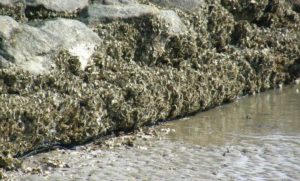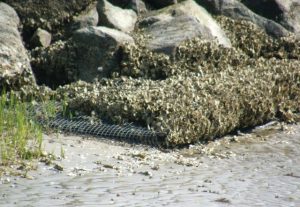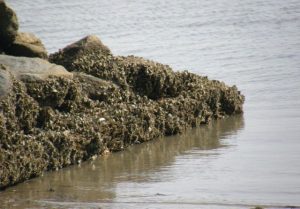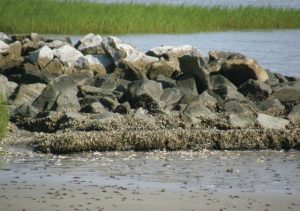Reef Re-Creation for Shoreline Protection


The Terrebonne Bay Shore Protection Demonstration Project points to one technique to help reduce shoreline erosion as well as promote oyster reef building.
As climate change and subsidence begin to endanger America’s coastal communities, city and state governments are struggling to stand their ground as it literally sinks below them. Larger cities such as Miami and Atlantic City are constructing seawalls and water pumps to fight back against the rising waters, but community members from Terrebonne Parish in southern Louisiana are betting on a different strategy: oysters.
Terrebonne Parish lies along the Gulf of Mexico, and of its total area of 2,082 square miles, 41 percent (850 square miles) of that is water. Rising seas are eating away the shoreline at an alarming rate, including the location of sacred burial sites for the Native American Pointe-au-Chien Tribe that calls the parish home. Because of marsh loss in the area, Lake Barre is no longer distinct from Terrebonne Bay, and consequently the interior salt marshes have become exposed to forces of waves and tides. These saline marshes provide a vital buffer zone between the more-saline Gulf of Mexico waters and the less-saline interior ecosystems.
Seven-Year Study
A team led by Dr. Earl Melancon, a professor emeritus from Nicholls State University who studies coastal restoration, and Glen Curole from the Coastal Protection and Restoration Authority of Louisiana (CPRA) embarked on a seven-year-long study of shore protection methods. The purpose of the study was to demonstrate, evaluate and document the effectiveness of three shoreline/foreshore protection techniques designed to reduce shoreline erosion and promote oyster reef building at the head of a bay or coastal lake.

These saline marshes provide a vital buffer zone between the more-saline Gulf of Mexico waters and the less-saline interior ecosystems.


Melancon and the CPRA measured the effectiveness of three different methods of shore protection. Tensar’s Triton Marine Mattress System was compared against a permeable matrix of interlocking concrete armor units and an artificial reef design made from steel and recycled oyster shells. Of the three methods tested, the Marine Mattresses created a much friendlier oyster habitat and thereby a greater oyster population. They also proved more effective than the two alternatives at curbing shoreline loss, both in terms of cost per linear foot and meters of shoreline loss per year.
A polymeric marine mattress or “gabion mat” is a cage structure composed of strong yet flexible Tensar Geogrid filled with aggregate. The mattresses are placed perpendicular to the shoreline and contour to it in a way that creates a gradual transition that dampens wave energy before it hits the shore.
“The sloping Marine Mattresses gave opportunity for oysters to colonize more readily, and that allowed for the creation of more reef structure,” notes Melancon. He further explained that the formation of reefs cushions the impact of waves on the shore, which in turn reduces overall shoreline loss.

The mattresses address the limitation at the toe of the slope and the need for energy absorption seen as necessary to protect the ecosystem.
Flexibility and Porosity
The Triton Marine Mattress System also addressed project conditions in a way the other systems could not by combining flexibility and porosity of the gabion mat. The mattresses address the limitation at the toe of the slope and the need for energy absorption seen as necessary to protect the ecosystem. According to Steve Williams, Tensar Industry Manager for Marine & Ports, the monolithic construction and mass of the mattress system can provide the capability of withstanding the energy of a storm event.
“The uniformity, strength, ease of installation, stability and porosity of the Tensar Triton Marine Mattress System tend to absorb wave energy and reduce wave run-up,” says Williams, adding that the structure of the mattress system makes it ideal for use on soft, non-compacted subgrade material.
About Todd Danielson
Todd Danielson has been in trade technology media for more than 20 years, now the editorial director for V1 Media and all of its publications: Informed Infrastructure, Earth Imaging Journal, Sensors & Systems, Asian Surveying & Mapping, and the video news portal GeoSpatial Stream.


